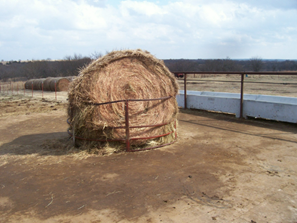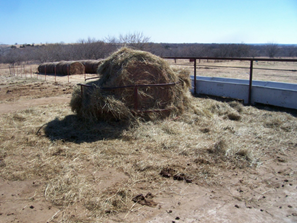Cow-Calf Corner | December 6, 2021
Drought impacts in 2021, 2022 and beyond
Derrell S. Peel, Oklahoma State University Extension Livestock Marketing Specialist
At the end of November, 69 percent of the U.S. was abnormally dry or worse with over 53 percent in some degree of drought (D1-D4) according to the Drought Monitor. The Drought Severity and Coverage Index (DSCI) is calculated from the D0-D4 categories and was 181 for the U.S. in the latest week. The weekly DSCI for the U.S. has averaged 171 for the year to date. The DSCI can take on values from 0 (no abnormally dry conditions) to 500 (100 percent of the region in D4 (exceptional drought).
In the Drought Monitor, the West region includes nine states (AZ, CA, ID, MT, NV, NM, OR, UT and WA). The West region has had an average DSCI of 213 for the year to date and is at 212 currently. The year-to-date average DSCI is highest for Utah in this region at 436, followed by NV (398), CA (373), AZ (365) and NM (347). However, the current DSCI is highest for CA (401), followed by MT (393), UT (388), OR (380), and NV (371). The High Plains region of the Drought Monitor includes CO, KS, NE ND, SD and WY. This region has had an average DSCI of 208 for the year so far and has a current value of 188. So far this year the highest average DSCI was in ND (318), followed by WY (258), CO (242) and SD (226). At the current time in the High Plains region, WY has the highest DSCI (278), followed by CO (262) and ND (213).
The drought values above indicate how beef cattle operations are affected in various locations. However, broader cattle market impacts may occur depending on the severity of drought and the size of the cow herd in various regions. Beef cow slaughter is up 8.6 percent for the year to date and includes some drought liquidation but from exactly where is unclear. I created an ad-hoc index that incorporates drought conditions as measured by the DSCI and the number of beef cows in the states that make up the West and High Plains regions. With drought impacts heavily weighted, the four states of ND, MT, CA and SD show the greatest likely impacts on the U.S. beef cow herd in 2021, with lesser national impacts in UT, NM, OR, WY, NV and CO. The annual Cattle report, due out January 31, 2022, will reveal exactly where and how much beef cow inventories changed along with other cattle inventory data.
Drought in the wintertime is generally not a major cattle market issue with limited exceptions, such as the winter wheat crop (winter wheat grazing). However, the extent and level of drought in the U.S. at this time is troubling because of the potential for drought to extend into the next growing season, at least in some regions. With dry conditions persisting since 2020 in some regions, many beef cattle operations have already made significant adjustments and will have very little flexibility if the current drought extends into 2022. This could result in another severe round of cow liquidation in the first half of next year. A decade ago, severe drought caused the unplanned liquidation of some two million beef cows and affected cattle markets for several years, arguably up to the current time. It is possible it could happen again.
Hay Feeder Design to Reduce Hay Waste
David Lalman, Oklahoma State University Extension Beef Cattle Specialist
Hay production in the Southern Great Plains has steadily increased over the last 50 years. Even though minimizing use of harvested forage would reduce cost of production and carbon footprint in most situations, it is a fact that the haying industry remains an enormous component in the Southern Great Plains agricultural landscape. Therefore, improving hay feeding efficiency represents “low-hanging fruit” in many seedstock and commercial operations.
Feeding strategies for large round bales can basically be separated into use of a hay feeder and rolling bales out. A major advantage to rolling bales out is improved distribution of hay waste and manure over the pasture, which should lead to improved soil fertility. Hoof action is also distributed over a larger feeding area, and this could lead to less soil compaction and (or) less sod/plant damage compared to concentrated feeding areas associated with hay feeders. The disadvantage to relying on unrolling hay is the need to feed every day if standing forage availability is limited. Hay waste is basically a function of the amount of hay provided per animal each day. The more restricted the amount of hay fed, the lower the waste and visa versa. If two or more days’ worth of hay must be fed at a time, expect hay waste to exceed 25% of the original bale weight. The term “waste” may be considered a matter of perspective, because the “wasted” hay does provide soil nutrients and organic matter to the system.
Several studies have investigated the influence of hay feeder design on the efficiency of hay utilization and hay waste. The lightweight (and therefore convenient), simple hay ring feeders remain popular for round bale feeding. However, the low original cost and light construction come at the expense of hay feeding efficiency. Researchers have consistently documented 19 to 21% waste, expressed as a percentage of the original bale weight, when these “open” feeders were used (Figure 1). Waste from feeding dry, long-stem grass hay can be reduced to about 12 to 13% simply by purchasing a feeder with a solid sheeted bottom. Finally, in four different experiments, feeders that combine a sheeted bottom feature with some type of a basket or cone mechanism have documented waste of dry grass hay between 3.5 to 8% of the original bale weight.
Efficient hay feeders generally restrict access to the top half of the bale. This limits cows’ ability to drag hay from the top of the bale directly onto the pen or pasture surface. Next, the basket or cone mechanism serves to hold the bale in the center of the feeder until it collapses below the basket. Finally, the basket mechanism creates a feeding space inside the feeder so that the cows are not constantly entering and exiting the feeder, dropping hay on the pen or pasture surface.
These features are not without drawbacks, however. First these more efficient hay feeders are going to cost considerably more than the simple, open style feeders. Placing a bale is going to require a tractor with a loader, although some feeders can be filled with a hydraulic truck bed. These more efficient feeders are considerably heavier and cannot be stood up and rolled to a new location as with the open style feeders. Finally, lighter calves may not be able to access the core of the bale in some models. Be sure to explore these potential issues before you purchase a feeder.
Figure 1. The image on the left is a 1,300-pound bale placed in an “open” steel ring hay feeder. The image on the right is the same bale and feeder after twelve cows had access to the bale for 24 hours.
Dave Lalman discusses how to get the most out of your hay on SunUp TV from October 22, 2018. Getting the most out of your hay (10/20/18) - YouTube
Baby Calf It’s Cold Outside
Courtney Bir, OSU Agricultural Economics Extension Farm Management Specialist
So far, fingers crossed, this fall/winter season has been much warmer than previous years. Past images of new-born calves being warmed up in trucks, and busy veterinarians made me wonder about the economic consequences of winter calving. Thanks to the efforts of many of you, we were able to collect data from ranchers and veterinarians to evaluate the financial implications of calving. We currently have a publication in process with Dr. Eric DeVuyst, Dr. Dave Lalman and our former graduate student Amanda Upton. Amanda successfully completed her thesis on this topic over the summer.
Our goal was to evaluate the implications of calving date on expected annualized return per head for a cow calf operation. We were working under the idea that early calving with increasingly cold winters in January may lead to more veterinary costs, higher death loss, and increased feed costs. We used information from a survey of producers, veterinarians, and feedlots, as well as simulated programming to get some answers.
Despite having really cold winters in recent memory, 62% of producers strongly disagreed that they see frozen ears/tails/legs on their cattle. Similarly, 10% of veterinarians who worked with 501-1,000 cattle saw 0-2% of the cattle with frost damage. The average for a veterinary call was approximately $70, and a cost of $5.70 was reported for frost related medication. Per the veterinarian survey, 48% of producers do not typically seek veterinary assistance with frost related issues. Only 13% of producers indicated that they strongly agreed that frozen ears/tails/lets are a problem. 56% of producers expected a discount per CWT at the sale barn of between $0.01 and $15.00 for frozen ears, tails, and legs. Despite the conversations regarding battling the winter elements as a cow/calf producer, the reality is that it is less of a problem than expected.
Calving in mid-March resulted in highest annualized returns per head. Most of the producers we surveyed calved in March. 58% of producers indicated that calving date was part of their grazing management strategy, and 52% indicated it was part of their marketing strategy. There were non-management factors behind calving date as well. For 34% of producers their chosen calving date was most convenient for them because the timing worked best with their off farm enterprises. For 30%the timing worked best with their off-farm job, and for 9% the timing worked best with their seasonal labor.
In short, despite the popularity of news clips, and 6 o’clock sound bites, the effect of winter weather in terms of frost damage to cattle was less of a problem than expected. Most producers were calving during the higher annualized return period of March. It is important to keep in mind that your operation may have other constraints, such as labor or other enterprise requirements that may make a different calving month a better option.


